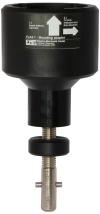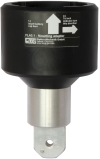Fault indicators
Type FLA3.1 series
The fault indicators of the type FLA3.1 series are used in overhead lines of a network. The indicators can be mounted under live conditions with the help of an adapter and a hot stick. The indication is either done by six flashing LEDs for a clear nighttime visibility and three red display areas for a clear daytime visibility. Or it is done by an ultra-bright LED with a focussing lense for optimum visibility during day- and nighttime.
The indicators of the type FLA3.1 series can communicate to a remote control via a bidirectional wireless connection. In this way all settings of the indicators can be adjusted at any time without removing the indicators from the powered line. The FLA3.1 series stands out for the great flexibility of the adjustments that can be done. Beside the basic settings of the indicator like trip current, response delay, reset time, etc., the indicators of the FLA3.1 series can be adapted to auto-reclosers in the network. This provides an optimized fault indication and also allows the indication of different types of faults. Permanent and temporary faults can be distinguished and indicated separately.
The bidirectional connection between the remote control and the fault indicator allows to read out the present current of the monitored network with the remote control at any time.
Advanced fault detection
The fault indicators of the type FLA3.1 series use different methods to detect faults.
| Detection method | FLA3.1 | FLA3.1V | FLA3.1VL |
| absolute threshold | X | X | X |
| automatic mode | X | X | X |
| di/dt detection method | X | X | |
| indication | flag + LED | flag + LED | ultra-bright LED with focussing lens |
Any of the methods can be enabled or disabled as required.
The fault indicator type FLA3.1V can be integrated into a SCADA system via the remote indication interfaces of the type RIS series.
The fault indicators of the type FLA3.1 series can also be connected to the remote indication interfaces type RIS-FR and RIS-FS. This allows an easy-to-install remote indication solution for the overhead line indicators.
| Order Data | ||
| Type FLA3.1 | 40.40.10 | |
| Type FLA3.1V | 40.46.10 | |
| Type FLA3.1VL | 40.47.10 | |
| Remote Control Type HS | | for type FLA3.1 | 40.30.10 |
| Remote Control Type HS | | for type FLA3.1V | 40.37.10 |
| Remote Control Type HS | | for type FLA3.1VL | 40.37.10 |
| Mounting adapter | | bayonet type | 40.52.10 |
| Mounting adapter | | clamp type | 40.52.11 |
| Mounting adapter | | universal spline type | 40.52.12 |






